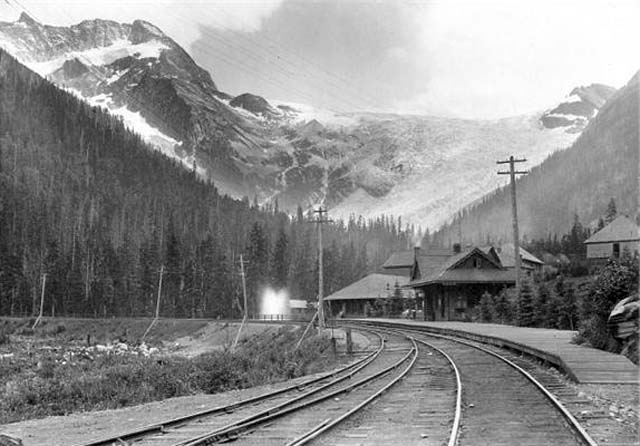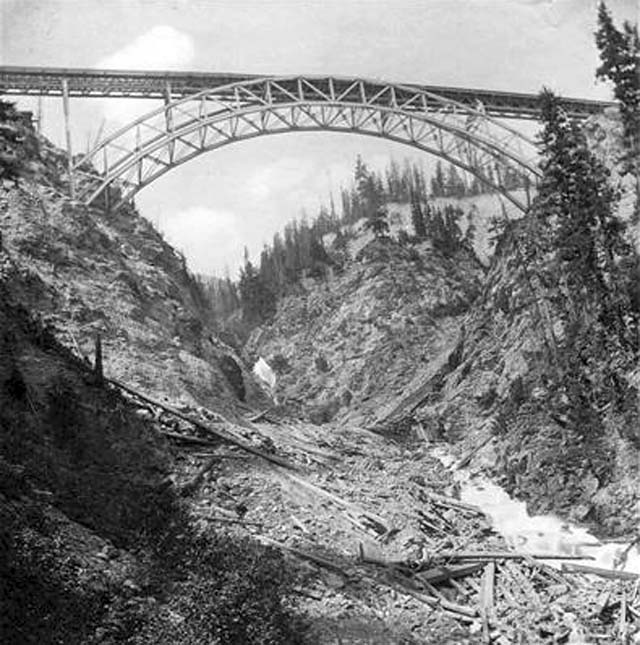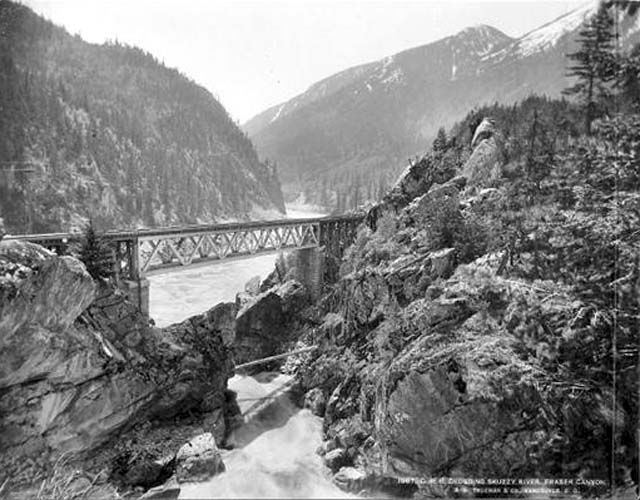
2012
|


Canadian Pacific Railway's Glacier House and the Great Glacier - Date unknown Richard Henry Trueman.
14 December 2012
Vintage Prints from Vancouver's Lost Master on Display
Vancouver British Columbia - When Toronto art dealer Christopher Varley was recently approached by someone with an album of old
photographs, he was surprised to find 25 vintage prints by Richard Henry Trueman, one of early Vancouver's great photographers.
There was a sweeping view of Granville Street looking north from Georgia about 1900, when the Victorian downtown was all brick and stone buildings. A
picturesque shot of the CPR ocean liner The Empress of India at a Coal Harbour wharf during a royal visit in 1901. A beautiful landscape photo featuring a
suspension bridge over the Fraser River at Spuzzum that was washed out in 1894.
The Vancouver Public Library has a collection of 240 glass-plate negatives by Trueman, but period prints like this are rare. Varley bought them, then convinced
Peter Ohler of the Masters Art Gallery to mount them in a show.
Thus we have "Richard Henry Trueman, Photographer of the West", an exhibition that runs at the Masters Gallery (2245 Granville St.) until
22 Dec 2012.
Details of Trueman's life are scarce. He was born in Brampton, Ontario, in 1856, and had a photo studio back east called the Popular Photograph Parlour. In
1888, he came west to Brandon, Manitoba. In 1889, he arrived in Vancouver, where he formed a partnership with Henry Caple.
The pair took some photos of Vancouver, but their bread and butter was scenic shots taken along the Canadian Pacific Railway line. The partnership ended in
1894, and Trueman spent a few years around Medicine Hat. In 1899 or 1900 he returned to British Columbia, opening studios in Sandon and Revelstoke along with
Vancouver, where he died in 1911.

Canadian Pacific Railway's Stoney Creek Bridge in the Selkirk Mountains before it was reinforced - Date unknown
Richard Henry Trueman.
Photographic technology in Trueman's era was primitive. He took his photos with a large view camera that was mounted on a tripod. In order to take his gorgeous
photo of the Stoney Creek Bridge in the Selkirk Mountains, he would have had to trudge down a mountainside through the wilderness with all his equipment before
he could set up on the creek bed underneath the bridge.
"You've got to take that big plate camera and all those glass plates to the spot, set it up, then you need the right light conditions and take the
photograph," says Varley. "And you've got to hope to God you get it home, back to the studio and printed (without breaking the glass negative)."
The difficulty of taking photos means there are very few left from the late 1800s and early 1900s.
"There's this fantasy that photography is ubiquitous, that photographs are everywhere," says Varley.
"But if you really look at the historical record, they're rare".
"I was looking at Percy Bentley's photographs (Bentley operated the Dominion Photo Company, whose collection is in the special collections department of
the Vancouver Public Library). "His log book at the Vancouver Library is like, In the morning I took a photograph of a storefront or drugstore, in the
afternoon took a photograph of a dead baby. I'm not kidding, this was 1917. They're not snapshots, it's not like today."

The bridge over Skuzzy Creek in the Fraser Canyon - Date unknown Richard Henry Trueman.
Most of the Trueman photos in the exhibition are landscapes. There is a fabulous photo of Mirror Lake in the Kootenays, where the trees along the shoreline are
indeed mirrored in the lake. Trueman photographed the Glacier House resort in Revelstoke with the CPR tracks leading into it, and the Great Glacier looming
behind. He took another photo of a man standing beside the Great Glacier, dwarfed by its size and beauty.
The clarity of the photos is incredible, a century later, the prints are crystal clear. It probably helps that they were kept in an album and out of the light,
which means they didn't fade. The prints from the album are all silver-gelatin, and were probably selected by someone from a Trueman catalogue. The latest
photo is dated September, 1901, so the purchaser probably picked them up in 1902, perhaps as a souvenir of their trip along the CPR through the west.
A century later, they're being shown in public, for the first time. In spite of their rarity, they're quite reasonably priced, at $675 for the silver-gelatin
prints, $875 for a single platinum print Varley acquired separately.
Varley normally deals in paintings, he's the grandson of Frederick Varley, the Group of Seven painter. But as a native Vancouverite, he loves finding old
images of his hometown and British Columbia.
"It's Vancouver, for God's sake, it's the early history of the city," he says. "They're really neat images that tell you a lot about the
west."
"The thing I love about photography and the west is the development of the west and photography go hand and hand. Photographers were there from the very
beginning. When they were building bridges, tunnels, they're there. You can't say that about Toronto and Montreal, it didn't happen."
John Mackie.

|


|
Vancouver Island
British Columbia
Canada
|
|



